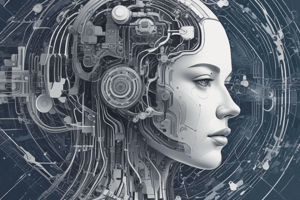Podcast
Questions and Answers
Which of the following is NOT a key application area of computer vision?
Which of the following is NOT a key application area of computer vision?
- Language translation (correct)
- Medical imaging
- Facial recognition
- Autonomous vehicles
What is the primary difference between traditional image processing and computer vision?
What is the primary difference between traditional image processing and computer vision?
- Traditional image processing focuses on modifying images, while computer vision focuses on identifying and locating objects within images. (correct)
- Traditional image processing is more advanced than computer vision.
- There is no difference between traditional image processing and computer vision.
- Computer vision is only used for facial recognition, while traditional image processing has broader applications.
Which of the following is NOT a common application of natural language processing (NLP)?
Which of the following is NOT a common application of natural language processing (NLP)?
- Image recognition (correct)
- Chatbots
- Sentiment analysis
- Speech recognition
What is the primary purpose of machine learning in AI systems?
What is the primary purpose of machine learning in AI systems?
Which of the following best describes the relationship between Machine Learning and Deep Learning?
Which of the following best describes the relationship between Machine Learning and Deep Learning?
Which of the following AI technologies is primarily focused on interpreting and understanding natural language?
Which of the following AI technologies is primarily focused on interpreting and understanding natural language?
What is the primary goal of AI systems that utilize Machine Learning techniques?
What is the primary goal of AI systems that utilize Machine Learning techniques?
Paradox Tool usage?
Paradox Tool usage?
which of the below is not AI Healthcare tool
which of the below is not AI Healthcare tool
Flashcards are hidden until you start studying
Study Notes
Artificial Intelligence (AI): An Examination of Deep Learning, Computer Vision, Natural Language Processing, Machine Learning, and AI Tools
Introduction
Artificial Intelligence (AI) refers to the simulation of human intelligence processes by machines, particularly computer systems. AI encompasses a wide range of technologies and techniques that allow machines to learn from data, recognize patterns, and make decisions with minimal human intervention. In recent years, AI has gained significant attention for its ability to automate tasks, enhance efficiency, and solve complex problems across various fields. This article explores AI, focusing on deep learning, computer vision, natural language processing, machine learning, and AI tools.
Deep Learning
Deep Learning is a subset of Machine Learning where neural networks with multiple layers are used to analyze data. These algorithms learn from large datasets, allowing them to recognize patterns and make decisions based on the information they have been trained on. Convolutional Neural Networks (CNNs) are commonly used for Computer Vision tasks, providing a multi-layered architecture that focuses on relevant features in images. CNNs have been integral in improving performance in tasks like object detection, localization, and image classification.
Computer Vision
Computer Vision is concerned with teaching machines to interpret and understand images and videos. It serves as the foundation for autonomous vehicles, facial recognition technologies, and medical imaging, among other applications. Traditional image processing focuses on modifying images and enhances them for specific purposes, while computer vision identifies and locates objects within images, enabling pattern recognition and decision-making.
Natural Language Processing (NLP)
Natural Language Processing is a subset of AI that focuses on enabling computers to understand, interpret, and generate human language. NLP is utilized in chatbots, sentiment analyzers, and speech recognition technology. By analyzing and processing human language, NLP allows computers to mimic human communication and interaction.
Machine Learning
Machine Learning is a branch of AI that involves creating algorithms capable of improving their performance over time through exposure to data. It enables machines to independently adapt to new inputs, making it an essential technology for applications like recommendation systems, fraud detection, and predictive maintenance. Machine Learning models require vast amounts of data to train effectively, allowing them to make better decisions and predictions based on patterns learned.
AI Tools
There are various AI tools available to developers and organizations to implement AI solutions. Some of the most popular ones include:
- OpenCV: A real-time computer vision library, offering over 2,500-plus classic and state-of-the-art algorithms for tasks like face detection and recognition, object identification, and image stitching.
- Viso Suite: A no-code computer vision platform that powers the leading edge-to-end computer vision system.
- TensorFlow: An open-source machine learning platform created by Google, supporting deep learning and distributed training.
- MATLAB: A programming language with built-in functions and toolboxes for computer vision tasks.
- Keras: A Python-based open-source library acting as an interface for TensorFlow, specifically suited for beginners.
These tools, along with other similar platforms, facilitate the implementation of AI solutions across various industries, streamlining operations, enhancing customer experiences, and driving innovation.
In conclusion, AI continues to transform the technological landscape, shaping industries and society in profound ways. Understanding the concepts of deep learning, computer vision, natural language processing, machine learning, and AI tools can enable individuals and organizations to leverage the full potential of AI in achieving operational excellence and driving growth.
Studying That Suits You
Use AI to generate personalized quizzes and flashcards to suit your learning preferences.




